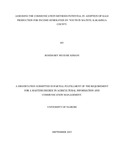Assessing the communication methods potential in adoption of kale production for income generation by youth in Matete, Kakamega county

View/
Date
2015-09Author
Kimani, Rosemary M
Type
ThesisLanguage
enMetadata
Show full item recordAbstract
Agriculture remains a major employer worldwide after service and is mainly carried out in small
scale, more than half a billion ageing farmers working in small land parcels to produce a large
amount of the world‟s food. Its slow growth rate of less than one percent annually falls short of
transformative and diminishes the prospect of rural youth finding decent work in many countries
in the developing and emerging economies. Young people are the key to the future of agriculture
but are plagued by low earnings and growing disinterest and are moving away to urban areas in
search of menial jobs. Youth who aspire to practice farming as a livelihood face many obstacles
some common to small scale producers and others related to their age group.
The study examines communication methods used among the youth for adoption of kale
production to generate income. The survey instrument targeted youths in kale production groups.
Our findings indicate that youth have access to multiple communication methods and just like
other small scale farmers preferred group and individual contact methods. These methods were
viewed to offer opportunity to interact with the service providers and builds trust. Farm and
office visits had no challenges. In mass communication methods, radios were the most utilized
though they were rated as less effective, useful and acceptable. Radio, telephone calls and
newspapers are important communication methods among the respondents. They are plagued by
challenges mainly from the service provider side of implementation that will need to be
addressed for their benefits to be realized.
We recommend the methods viewed positively by the respondents and that have few or no
communication challenges such as farm visits, office visits, group meetings, demonstrations and
field days be enhanced when reaching the youth.
We recommend further studies on use of ICT by service providers and the youth to shade light
on issues affecting their use and hence in coming up with ways of addressing the communication
problems.
Keywords: Communication methods, adoption, youth, income generation.
Publisher
University of Nairobi
